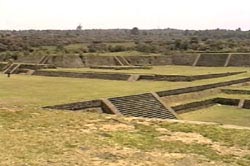|
On the Mexican plateau, fifteen miles from the city of Toluca, capital of the State of Mexico, is found Tetepetl Hill, on the summit of which are found the remains of Teotenango, a matlazinca settlement that remained undiscovered until 1971. Among the ruins of the settlement is a group of pyramids and a ball game field, as well as remains of housing constructions, which suggest that Teotenango was, besides a significant ceremonial center, an urban area of great importance.
The study of the archeological remains indicates that, in spite of the great quantity of exposed constructions, there are still over 500 structures that remain hidden. The founders of Teotenango, whose ancestors settled in the region around 800 A.D., chose the top of the Tepetl Rock because of the safety it provided them. They built one of the few walled cities in the prehispanic period. A sudden precipice was the natural defense of the city. The rest of the perimeter was protected by a system of walls that multiply themselves and combine with ditches in the central area. All was erected in harmony with the natural surroundings. Transversally the city reaches almost 4,500 feet. Various constructions are found on this terrain, such as the base of pyramids, platforms, palaces, housing complexes, as well as the aforementioned defense system, streets, and draining and water supply systems connected to the natural local springs.
Of special interest are the court for the Juego de Pelota or Ball Game, of closed and sunken kind, with its base in the shape of an ‘I’; and the Temazcal, which was like a steam bath used for the purpose of healing or ritual cleansing. The rocks would be heated in the center floor and would produce steam when sprayed with water. A great number of engravings were carved on rocks, depicting a variety of signs and symbols, among which we find the Jaguar Monolith, the Serpent Structure and the Frog Sculpture. The topography of the land made it challenging to construct monuments and plazas, but creative architectural solutions work around the obstacles in a capable and harmonious way, achieving a monument of impressive characteristics. The matlatzincas were eventually conquered by the Aztecs, and when the great Tenochtitlan fell, Hernan Cortes sent captain Martin Dorantes to occupy Teotenango and in 1550 he founded the current town at the base of the hill.
The architectural talent of the great matlatzincas was evident to the locals, the Spanish, natives, and mestizos as they proudly looked upon the parish church of La Asuncion, the urban design, the fountain, and all of the constructions of the colonial villa of Teotenango: “This town of Teotenango came down from the hill to this plain and its streets are designed like Mexico’s.” Since ancient times the people of the region have felt a special pride for its constructions; they had it then, still have it now, and will likely have it tomorrow. Teotenango, an example of the best of the latin spirit. |
|
|
 Can
you lose over 500 buildings on a hill?
Can
you lose over 500 buildings on a hill?